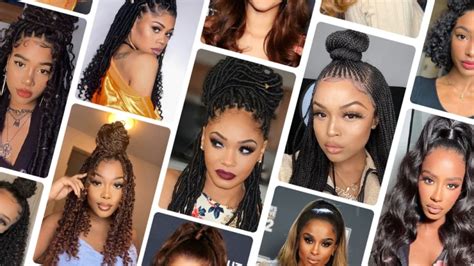The vibrant tapestry of hair textures, patterns, and styles within the African diaspora is a testament to the rich cultural heritage and boundless creativity of Black people. From intricately braided crowns to chic bobs and edgy fades, hairstyles serve as a profound expression of self, identity, and cultural connection.

The Art of Black Hair: A Journey through History
Throughout history, Black hair has been both a source of pride and a subject of societal scrutiny. During the era of slavery, hairstyles such as the headwrap became a symbol of resistance and cultural preservation. In the 20th century, the civil rights movement ignited a renewed appreciation for natural Black hair, leading to the rise of the Afro and other empowering styles.
Today, Black hairstyles continue to evolve, reflecting the multifaceted nature of modern-day society. They serve as a means of individual expression, while also embodying a collective cultural heritage and a celebration of diversity.
Understanding Hair Texture and Patterns: A Guide to Types
The unique characteristics of African hair are due to the shape of its hair follicles. Black hair ranges from fine and straight to coarse and tightly coiled, with variations in texture and curl pattern creating a vast array of styling possibilities.
Some common hair patterns include:
- Type 3: Curly hair with defined ringlets that tend to shrink or curl when fully dry.
- Type 4: Coily hair with tightly packed, s-shaped curls that can be fragile and prone to breakage.
- Type 4a: Coily hair with a tighter curl pattern than Type 3.
- Type 4b: Coily hair with a sharp, zigzag curl pattern.
- Type 4c: Coily hair with a very tight, zig-zag curl pattern, often described as “kinky.”
Hair Health and Maintenance: Nurturing Your Locks
Maintaining healthy Black hair requires a customized approach that considers its unique texture and needs. Proper care practices include:
- Regular deep conditioning to moisturize and strengthen hair.
- Limiting heat styling and chemical treatments to minimize damage.
- Protecting hair from the sun’s harsh UV rays with hats or scarves.
- Adopting a healthy diet rich in vitamins and minerals to support hair growth.
Embracing Versatility: A Canvas for Creative Expression
The versatility of Black hair is unparalleled, allowing for a boundless range of styling options:
- Braids: Intricate cornrows, box braids, and Senegalese twists create protective styles that can last for weeks and add texture and volume.
- Natural styles: Embracing the natural texture of Black hair through wash-and-gos, twists, and bantu knots showcase its unique beauty.
- Cuts and shapes: Modern haircuts such as fades, undercuts, and bobs add a touch of edge and sophistication to any style.
- Extensions: Human hair or synthetic extensions provide added length and volume, creating voluminous ponytails, braids, and updos.
Celebrating Cultural Heritage: Hair as a Source of Identity
Hairstyles hold deep cultural significance within the African diaspora. They symbolize personal identity, community affiliation, and historical roots:
- Dreadlocks: Associated with spirituality and the Rastafari movement, dreadlocks are formed by the natural matting of hair.
- Afros: A symbol of empowerment and pride, the Afro represented the Black Power movement and became a statement of cultural identity.
- Headwraps: Traditional headwraps have been worn by women of African descent for centuries and represent modesty, cultural identity, and religious significance.
Empowering Individuals: Hair as a Reflection of Self
Hairstyles can serve as a powerful tool for personal expression and empowerment. They can:
- Boost confidence and self-esteem by embracing natural features and celebrating cultural heritage.
- Promote individuality by allowing people to experiment with different styles and find what suits them best.
- Foster a sense of community by connecting with others who share similar hair textures and experiences.
Addressing Hair Discrimination: A Call for Social Justice
While Black hair is a source of pride and cultural expression, it has also been subject to discrimination and bias. Societal norms and stereotypes often favor certain hair textures and styles over others, leading to unfair treatment in various settings:
- The “Crown Act” (Creating a Respectful and Open World for Natural Hair Act), which has been passed in several states, prohibits discrimination based on natural hair textures or styles.
- School dress codes that restrict certain hairstyles and force Black students to conform to Eurocentric norms have been challenged as discriminatory.
- In the workplace, studies have shown that Black women with natural hairstyles may face bias and discrimination in hiring, promotions, and advancement.
Conclusion: Embracing the Beauty and Diversity of Black Hair
The hairstyles of Black people are as diverse and vibrant as the cultures they represent. From protective braids and natural styles to modern cuts and extensions, there is a hairstyle for every individual to embrace their unique beauty and celebrate their cultural heritage. By fostering an appreciation for the versatility and cultural significance of Black hair, we can create a more inclusive and equitable society that embraces diversity and empowers individuals to express themselves freely.
